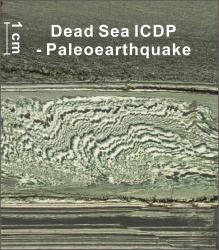1. Key points
This is the first attempt to apply a computational fluid dynamic modeling-based quantitative “fossil seismograph” to develop a large earthquake record.
The record is calibrated to historic earthquakes, for which the Dead Sea area has a famously long span, and it confirms a clustered earthquake recurrence pattern and a group-fault temporal clustering model.
The record yields much shorter mean recurrence for large (≤ 1.4 kyr vs. 7-11 kyr) and moderate (≤ 500 yr vs. 1600 yr) earthquakes than previously obtained, thus reveals a much higher seismic hazard than previously appreciated on this slow-slipping plate boundary.

2. Overview
The understanding of earthquakes in general and seismic hazard in particular, relies on our knowledge of past seismic history. The longer a time window that a record spans, the better that understanding can be. However, large earthquakes (moment magnitude, Mw ≥7.0) usually have recurrence intervals longer than the time span of modern seismograph operation of about a century, and infrequently occur on individual faults. In addition, earthquake recurrence patterns of slow-slipping faults (< 5 mm yr-1), e.g., the Dead Sea Fault, are more difficult to determine because they usually have longer interseismic intervals. Subaqueous paleoseismology exploits lacustrine and marine sediments to retrieve much longer records of paleoseismic shaking. Such long records can probe our understanding of the physical behavior of fault systems in the wake of large seismic events and are therefore essential for improving seismic hazard assessment.

Fig. 1. Tectonic setting of the Dead Sea Fault. (A) Dead Sea Fault is a sinistral boundary between the African and Arabian plates. (B) Major active faults along the plate boundary, Dead Sea Transform; in this area, the fault is composed of four fault segments. The red star marks the drilling site; the black points mark places referred to in the study; the magenta triangles indicate historic and instrumental Mw ≥6.0 earthquakes near the drilling site; ICDP: International Continental Scientific Drilling Program. (C) The gray bars represent the fault rupture of historic Mw ≥7.0 earthquakes since 31 BC that occurred along the focused part of the fault – the central Dead Sea Fault (up to 150 km north and south of the drilling site).
The Dead Sea Fault, a left-lateral, > 1,000-km-long strike-slip plate boundary separating the African and Arabian plates, is one of the most famous earthquake-generating faults on Earth. The Dead Sea, the lowest place on Earth (-433 m), is situated on the central part of the fault. In 2010-2011 a 457 m-long sediment sequence, spanning the past 220,000 years, was obtained in the 300 m deep central Dead Sea by the International Continental Scientific Drilling Program (ICDP). More than 400 earthquake-caused soft-sediment deformation structures were identified in this core. These structures are very similar to those softly deformed in other environments (e.g., air and ocean), suggesting a common mechanism, Kelvin Helmholtz instability. During earthquake shaking, the upper less-dense mud moves much faster than the lower denser mud (in the same direction), creating shear localized at the layer interface. These subtle structures are subsequently buried by new layers, resetting the system to record the next shaking event. The resulting sedimentary record in the center of the Dead Sea has recorded hundreds of earthquake shaking events with different shaking intensities over the past 220,000 years.

Fig. 2. Paleoearthquake indicators in the ICDP Core 5017-1. (A-J) in situ folded layers; (A, B) linear waves, (C-F) asymmetric billows, (G-J) coherent vortices. (K-M) Intraclast breccia layers. The vertical light blue bars indicate the position of events. Core depth: (A) 11010.0-11012.0 cm; (B) 16604.0-16608.0 cm; (C) 10929.9-10932.4 cm; (D) 26582.7-26585.2 cm; (E) 32861.0-32862.5 cm; (F) 35921.8-35923.8 cm; (G) 13754.4-13758.0 cm; (H) 10605.4-10606.9 cm; (I) 36425.9-36427.9 cm; (J) 12528.0-12532.0 cm; (K) 14492.5-14500.0 cm; (L) 39206.4-39210.4 cm; (M) 10772.0-10787.0 cm.
To recover shaking intensity from the recorded structures, we ran a series of 2-D numerical simulations using the physical properties of the soft sediments at the bottom of the Dead Sea. Using the Kelvin-Helmholtz instability mechanism, we model the ground acceleration needed to produce each deformed structure. These accelerations correspond to different levels of earthquake shaking intensity. These can be converted to earthquake magnitudes by considering earthquake ground motion attenuation in the region, fault geometry, and other limiting conditions. We found that over the past 220,000 years large earthquakes occurred with recurrence times ranging from a few years to a few thousand years, with a mean of 1400 years. This mean recurrence time is significantly shorter than the previous estimate of 7 to 11 thousand years, thus revealing an unexpectedly high seismicity rate on a slow-slipping (< 5 mm/year) plate boundary. In addition, unlike the periodic recurrence of earthquakes on fast-slipping and geometrically simple strike-slip faults, e.g., the Wrightwood Section of the San Andreas Fault and Alpine Fault in New Zealand, our work confirms a clustered recurrence pattern for large earthquakes on the slow-slipping Dead Sea Fault.

Fig. 3. Numerical simulation on in situ folded layer and intraclast breccia structures in the Dead Sea sedimentary sequences. (A) Typical structures from the Dead Sea depocenter Core 5017-1. (B) Typical structures from Dead Sea onshore outcrops (Fig. 1B). (C) Schematic diagrams based on snapshots from the numerical simulations demonstrating the four structures. (D) Quantitative estimation of the accelerations that are needed to initiate the four structures with different thicknesses; the deformations normally occurred when Richardson number ≤0.125.

Fig. 4. Return time statistics of seismites and magnitude constraint for strong seismic shaking events during the past 220 kyr. (A) Temporal distribution of moderate (PGA ≥0.13 g) and strong (PGA ≥0.34 g) seismic shaking events; PGA, peak ground acceleration; COV, coefficient of variation. (B and C) Histograms for return times of PGA ≥0.13 g and PGA ≥0.34 g events. We plot two distribution types (exponential and power-law) for each dataset. (D) Normalized return time data to show return time distribution of moderate and strong seismic shaking events. (E) Magnitude constraint for strong seismic shaking events by applying the three regional empirical attenuation relations, taking the past two kyr earthquake scenario as an analogy for the paleoseismic record, and assuming that most Mw ≥6.0 earthquakes occurred with D ≥30 km from the drilling site; D, epicentral distance. (F) Comparison of different temporal distributions of large earthquakes on the central Dead Sea Fault Zone derived from three different geological records. (G) Magnitude-frequency distribution of modern (olive colored) and paleo-earthquakes (pink colored) on the central Dead Sea Fault during the past 220 kyr; the number of modern earthquakes is extrapolated to 220 kyr.
This research was supported by the University of Liege under Special Funds for Research, IPD-STEMA Program (R.DIVE.0899-J-F-G to Y.L. between 2019 and 2020), Post-Doctoral Fellowship of the Faculty of Exact Sciences at Tel Aviv University (to Y.L. between 2016 and 2017), the Israel Science Foundation (Center of Excellence Grant #1436/14 and grant #1645/19 to S.M.; grant #363/20 to N.W(e).), the DESERVE (Dead Sea Research Venue) Virtual Institute under the auspices of the Helmholtz Association (https://www.deserve-vi.net/) (to A.A.), and the International Continental Scientific Drilling Program (ICDP).
3. Outlooks
In this work, we consider the seismites of “in situ soft-sediment deformations” only, and do not include any other types of seismites such as seismogenic mass movement deposits. This because, firstly, only the seismic shaking intensities of in situ soft-sediment deformations can be quantitatively estimated via numerical simulation. Secondly, in the present work, we are focusing on the strong seismic shaking events. Previous studies have shown that the seismic intensity threshold for the initiation of seismogenic mass movement deposits is MMI ~VI. However, the intensity threshold for the initiation of “intraclast breccias” and “coherent vortices” (two types of “in situ soft-sediment deformations”) in the Dead Sea are MMI ~VIII.
So, the present seismic record may still not complete regarding moderate earthquakes. In the next step (funded by Austrian Science Fund), we will consider both earthquake-caused secondary sedimentary effects (seismogenic mass movement deposits; Lu et al., 2017, JGR & 2020, GRL) and in situ effects (micro faults/fault-graded beds & in situ soft-sediment deformations) to develop a more complete 220 kyr-long moderate earthquake record. In addition, we are considering to improve our numerical simulation by including an analog model.
4. More details can be found on:
https://www.researchgate.net/profile/Yin_Lu22
https://advances.sciencemag.org/content/6/48/eaba4170

(微信公众号 “古地震”).



No Comments
No comments yet.